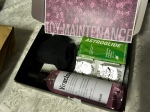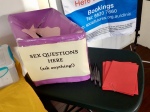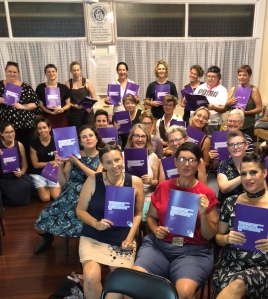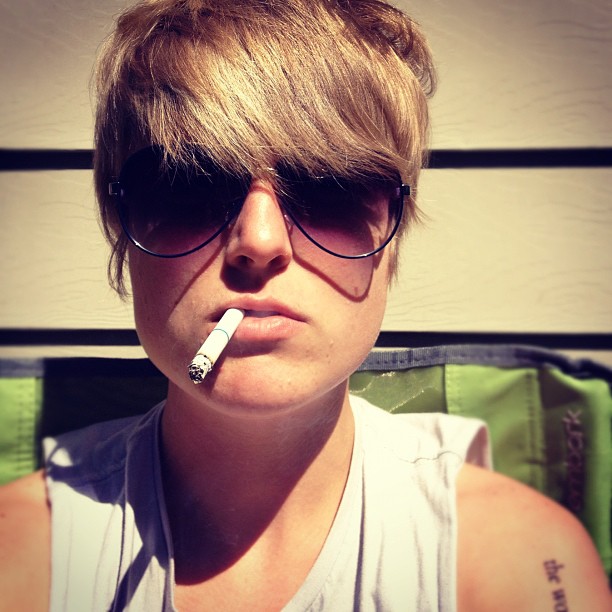 The CWA – Country Women’s Association are the largest women’s organisation in Australia and work to improve the conditions of women and children in the country. They’ve been around since the 1920s. They are an Australian institution no doubt, famous for their cookbooks and cake competitions.
The CWA – Country Women’s Association are the largest women’s organisation in Australia and work to improve the conditions of women and children in the country. They’ve been around since the 1920s. They are an Australian institution no doubt, famous for their cookbooks and cake competitions.  Their motto is all God, throne, country… For me, “the CWA” conjures up no-nonsense, white, entirely heterosexual ladies (excuse me my stereotyping). So you can imagine my surprise when I discovered my talk about lesbian, bisexual and queer women’s safer sex was to be at the Lismore CWA Tea Rooms.
Their motto is all God, throne, country… For me, “the CWA” conjures up no-nonsense, white, entirely heterosexual ladies (excuse me my stereotyping). So you can imagine my surprise when I discovered my talk about lesbian, bisexual and queer women’s safer sex was to be at the Lismore CWA Tea Rooms.
Mostly, when I talk about community-engaged/community-based research it’s all about front loading: getting community involved in research development, in data collection and only occasionally in data analysis. But this community event was about research translation – telling an affected community what we have found out, giving back the knowledge we gained through them about LBQ women and sexual health. SWASH, our twenty year health survey, has generated a lot of data on sexual practice, relationships, risk practices, and screening, but it’s been a long time since we’ve shared it.
This was not a stuffy or even a shiny university research forum. The night began with some young local women singing – there was no cash, so they got paid in donated but new sex toys! There was a giant pot of tea, biscuits, and plenty of vegan and gluten-free hot food.  Home made signs and rainbow bunting abounded, with raunchy images from LBQ women’s safer sex campaigns stuck to the walls of the tea room. There was a table of information about local sexual health services and another table full of free viraclean for sex toys, condoms, lube, and gloves from the always awesome ILOVECLAUDE. My research finding were imperfectly projected on a bed-sheet. The lucky door prizes were sex toys and most people won something!
Home made signs and rainbow bunting abounded, with raunchy images from LBQ women’s safer sex campaigns stuck to the walls of the tea room. There was a table of information about local sexual health services and another table full of free viraclean for sex toys, condoms, lube, and gloves from the always awesome ILOVECLAUDE. My research finding were imperfectly projected on a bed-sheet. The lucky door prizes were sex toys and most people won something!
There was a lot of laughing, some whispered confessions and a lot of generosity in the room. One older woman told me about the first time she’d seen a dental dam, and her complete confusion about how exactly it would help. Another told me about the first time she’d received instruction about safer sex for sex with a woman many years ago: a bucket of warm soapy water beside the bed to wash your hands between orifices/bodies. Women talked about where to find a safe GP, where to get safer sex supplies, and how you might start a conversation with a lover about preventing STI transmission. There was a lot of frank conversation about what we do, what we know, and what we aren’t sure about. What women didn’t know or didn’t feel sure about resonated very strongly with Ruby Grant’s recent research with queer young women in Tasmania, Jen Power’s earlier work with lesbian and bisexual women in Victoria, and some of my own work with younger LBQ women in Sydney (more citations at the end of this blog). .
We had a sexual health doctor in attendance (Dr Kate Bolam from Choices Clinic) and women posted anonymous questions throughout the night for her to answer. Several questions came in response to my presentation. I doubt anyone would have asked about the risks involved in oral sex and menstrual blood except I told them three quarters of LBQ women said in the last 6 months they had performed oral sex during menstruation without a barrier (Juliet Richters published this SWASH analysis ).  If they’d read this in a research report, I wonder what they would have done with the uncertainty this produced for them? How would they have gotten answers to questions about their own practice – should they avoid oral sex, try to get dental dams (your best bet is ILOVECLAUDE), or use a tampon (apparently provides little protection). There is a serious dearth of good quality and relevant sexual health information for LBQ women (see citations at the end of this blog). The event gave them the means to take the research findings and apply them to their lives and their practices.
If they’d read this in a research report, I wonder what they would have done with the uncertainty this produced for them? How would they have gotten answers to questions about their own practice – should they avoid oral sex, try to get dental dams (your best bet is ILOVECLAUDE), or use a tampon (apparently provides little protection). There is a serious dearth of good quality and relevant sexual health information for LBQ women (see citations at the end of this blog). The event gave them the means to take the research findings and apply them to their lives and their practices.
I can take little credit for the event. ACON asked me to participate. The amazing staff at ACON Northern Rivers are deeply connected community people and so could judge the level, the tone, and how to make it work for local women rather than for an out of town academic (no one in the room was likely to cite my work in peer review, there was no local dignitary to shake my hand for the local paper’s photographer, no formal evaluation. I left feeling pretty convinced that community-oriented research translation needs community partners taking the lead.
At the end of the night I realised just how appropriate it was that we held our event in a CWA Tea Room. Both the CWA and SWASH are about a group of people getting together and mustering scare resources in service of their community. Through the community, for the community, and by the community.
What do we know about LBQ women and safer sex in Australia? (let me know if you get stuck at a paywall)
Cox, Peta, McNair, Ruth (2009) Risk reduction as an accepted framework for safer-sex promotion among women who have sex with women. Sexual Health, 6:15-18.
Grant, Ruby, Nash, Meredith (2017) Navigating unintelligibility: Queer Australian young women’s negotiations of safe sex and risk. Journal of Health Psychology, 23(2): 306-319
McNair, Ruth (2005) Risks and prevention of sexually transmissible infections among women who have sex with women. Sexual Health, 2: 209-217.
McNair, Ruth, Power, Jennifer, Carr, Susan (2009) Comparing knowledge and perceived risk related to the human papilloma virus among Australian women of diverse sexual orientations. Australian and New Zealand Journal of Public Health, 33: 87–93.
Mooney-Somers, J, Deacon, RM, Klinner, C, Richters, J, Parkhill, N (2017) Women in contact with the gay and lesbian community in Sydney: Report of the Sydney Women and Sexual Health (SWASH) Survey 2006, 2008, 2010, 2012, 2014, 2016. Sydney: ACON & Sydney Health Ethics, University of Sydney.
Power, Jennifer, McNair, Ruth, Carr, Susan (2009) Absent sexual scripts: lesbian and bisexual women’s knowledge, attitudes and action regarding safer sex and sexual health information. Culture, Health & Sexuality, 11(1):67-81
Richters, Juliet, Prestage, Garrett, Schneider, Karen, Clayton, Stevie (2010) Do women use dental dams? Safer sex practices of lesbians and other women who have sex with women. Sexual Health, 7: 165–169.

 Exactly a year after we started data collection at the Lismore Women’s Festival, we returned to launch our regional report. Based on surveys from 245 respondents living in the Northern Rivers and Mid North Coast of NSW, this is a comprehensive snapshot of critical health indicators; download the full regional report
Exactly a year after we started data collection at the Lismore Women’s Festival, we returned to launch our regional report. Based on surveys from 245 respondents living in the Northern Rivers and Mid North Coast of NSW, this is a comprehensive snapshot of critical health indicators; download the full regional report  I wrote this plan on my office door, and added a note inviting people to ask me about my progress. I shut my door when I was working so everyone knew they would be interrupting my writing hour.
I wrote this plan on my office door, and added a note inviting people to ask me about my progress. I shut my door when I was working so everyone knew they would be interrupting my writing hour. “Binge writers foolishly search for big chunks of time, and they “find” this time during the evenings and weekends. Binge writing thus consumes time that should be spent on normal living. Is academic writing more important than spending time with your family and friends, petting the dog, and drinking coffee? A dog unpetted is a sad dog; a cup of coffee forsaken is caffeine lost forever. Protect your real-world time just as you protect your scheduled writing time.”
“Binge writers foolishly search for big chunks of time, and they “find” this time during the evenings and weekends. Binge writing thus consumes time that should be spent on normal living. Is academic writing more important than spending time with your family and friends, petting the dog, and drinking coffee? A dog unpetted is a sad dog; a cup of coffee forsaken is caffeine lost forever. Protect your real-world time just as you protect your scheduled writing time.”

 We couldn’t present all the findings (we have ~50 questions) so we stuck to new questions, topics I know ACON is currently doing work around (breast health, AOD treatment service), and issues we’ve been tracking for some time (eg smoking).
We couldn’t present all the findings (we have ~50 questions) so we stuck to new questions, topics I know ACON is currently doing work around (breast health, AOD treatment service), and issues we’ve been tracking for some time (eg smoking).



 The
The  Their motto is all God, throne, country… For me, “the CWA” conjures up no-nonsense, white, entirely heterosexual ladies (excuse me my stereotyping). So you can imagine my surprise when I discovered my
Their motto is all God, throne, country… For me, “the CWA” conjures up no-nonsense, white, entirely heterosexual ladies (excuse me my stereotyping). So you can imagine my surprise when I discovered my  Home made signs and rainbow bunting abounded, with raunchy images from LBQ women’s safer sex campaigns stuck to the walls of the tea room. There was a table of information about local sexual health services and another table full of free viraclean for sex toys, condoms, lube, and gloves from the always awesome
Home made signs and rainbow bunting abounded, with raunchy images from LBQ women’s safer sex campaigns stuck to the walls of the tea room. There was a table of information about local sexual health services and another table full of free viraclean for sex toys, condoms, lube, and gloves from the always awesome  If they’d read this in a research report, I wonder what they would have done with the uncertainty this produced for them? How would they have gotten answers to questions about their own practice – should they avoid oral sex, try to get dental dams (your best bet is
If they’d read this in a research report, I wonder what they would have done with the uncertainty this produced for them? How would they have gotten answers to questions about their own practice – should they avoid oral sex, try to get dental dams (your best bet is